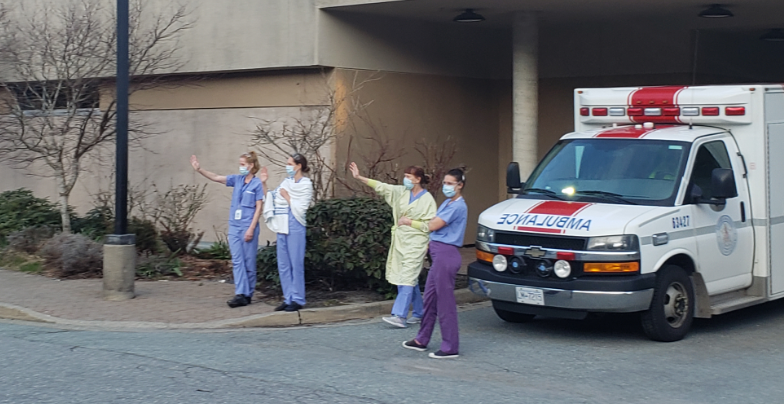
The recent banging of pots at 7 pm to recognize the extremely valuable work of emergency and medical workers should motivate us all to think about the future for them?
When the 7 pm air is silent after the pandemic, will there be any form of tangible recognition except the memory of the pots banging?
Communities have come to recognize how valuable our emergency and medical workers really are.
How can we continue to recognize their contribution while enabling our communities to be safe and secure? Is it not wise to have these workers close by, ready to go into action when the time comes?
One way to ensure they are here daily, and in the event of a future emergency, is to provide a home for them in our community. Time for some new or updated thinking.
The Canadian Armed Forces, most universities and almost all mining and forestry operations have found a solution to the problem of accommodation to meet their human resource needs – housing.
The Armed Forces call them PMQ’s or married quarters or barracks. Universities call them student residences. Mining companies call them bunk houses.
What is quite amazing is that each of these operations is clearly not in the real estate business. Yet, they are deeply into the real estate and accommodation business. Why? They need to have their people close by and ready to meet their goals and daily work.
The fire fighters, police, emergency workers, hospital staff and now more than ever, our senior care home workers, need to be close by.
Why then, do most municipalities have a challenge in housing these most needed people? High rents and often little rental housing and the high cost of home ownership mean many of these low- to-moderate-income critical workers live in distant, less expensive areas and must add travel time to their shift work.
One must hope there is no landslide or highway closure when the fire truck needs to go out and the crew is ‘on the way’.
Housing is normally each person’s own responsibility — until it is not. Only recently has housing become a growing reality that communities are addressing.
Non-private housing has a long history dating back to Bavaria in the 16th Century. Many forms of state, social, community or subsidized housing have followed, each with pros and cons.
Mostly, communities stress private ownership but there are many examples of government involvement in housing. In Canada, the Wartime Housing Limited (1941-47) built 26,000 wartime houses for military families. The lack of building repairs during the 1930’s Depression and the coming baby boom of the late 1940’s and 50’s required a government housing strategy.
Is the pandemic not a war? Are we not going to face some form of recession? Do we not have emergency workers in need?
The need to reframe the questions is already here.
Only recently has the Federal Government created the National Housing Strategy (NHS) which includes a Community Housing component and the recent BC Housing Action Plan is now in place.
Squamish has worked hard to use these documents to prepare the Affordable Housing Plan, (March 2018). Squamish has identified many strategies and approaches to housing needs. These government documents are a mix of philosophy, strategies, and financial structures to address housing needs. Strata homes, laneway homes and cooperative homes are now part of the fabric of our community.
These government plans tend to focus on the vulnerable and disadvantaged with supportive housing, women’s transition, indigenous, the homeless and seniors.
These are key groups that must be first on the priority list and they tend to be well represented in housing strategies. Emergency workers – less so.
The Squamish ‘Affordable Housing Framework (2013) is an excellent document.
One identified gap in the housing continuum is not addressed in the above plan – attainable home ownership for moderate‐income families.
As noted earlier, families trying to buy in the housing 2013 Affordable Housing Framework for Squamish 23 market with moderate incomes (incomes below $57,167 or less than 80% of the median income according to Statistics Canada) are continuing to find it hard to enter the home-ownership market, as was true in 2005, when the Affordable Housing Strategy was adopted in the District. (Part 3, P. 20)
Housing for emergency workers is not even mentioned.
With the current Corvid-19 crisis, the immediate need for the frontline workers to have affordable housing is important and even urgent.
Climate change is already bringing emergency-level issues forward in a whole new way. We need to house our emergency and frontline worker bees in the communities in which they serve. The Affordable Rental Housing Project on Buckley Avenue makes sense.
Perhaps the District of Squamish can carve out a new housing category called ‘Essential Services’ and make room for these key workers in its housing policy. Perhaps doing this before the next emergency is wise. We will all feel safer knowing the community is in good and nearby hands.
Could Squamish become the leadership model for this shift in thinking? Some community must recognize this need in a concrete way
‘A Place for Mom’ should also mean a place for emergency, medical and nursing home workers.




Douglas R Day says
Very good article Larry
Larry Murray says
Thanks Doug.